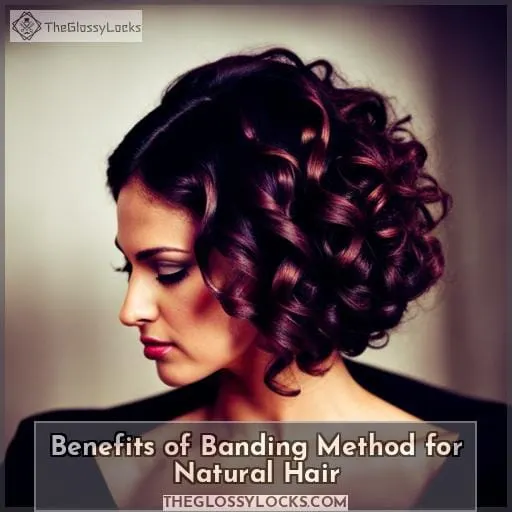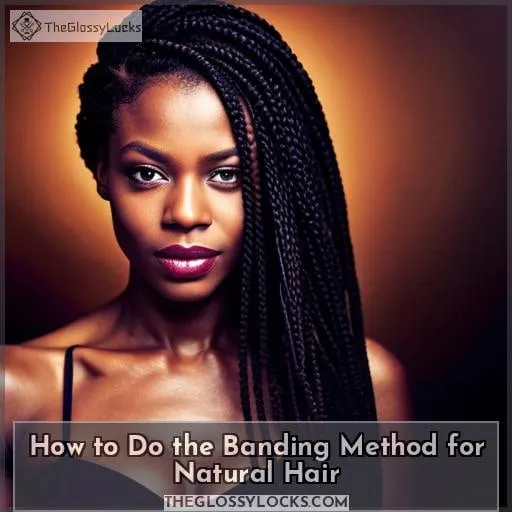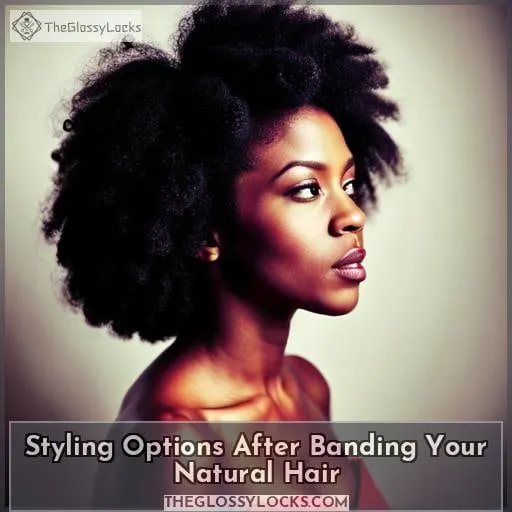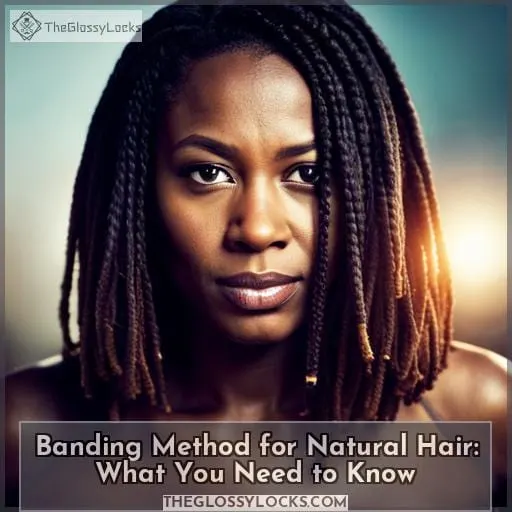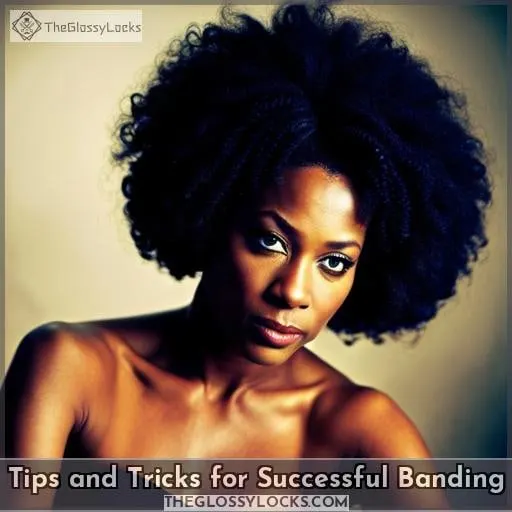This site is supported by our readers. We may earn a commission, at no cost to you, if you purchase through links.
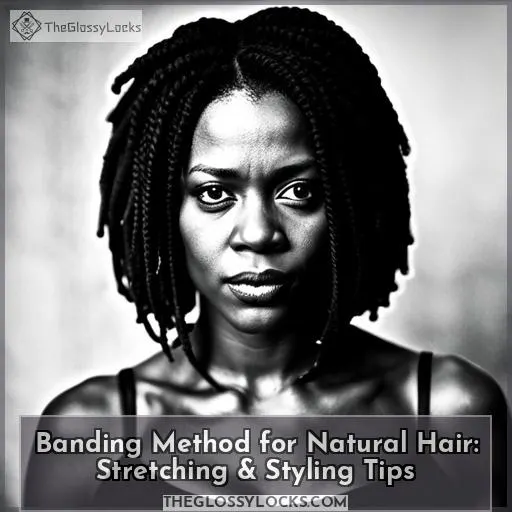
In this article, we’ll look at how banding can benefit your curls, as well as providing you with step-by-step instructions and styling options tailored specifically for type 4C hair.
Table Of Contents
- Key Takeaways
- Benefits of Banding Method for Natural Hair
- How to Do the Banding Method for Natural Hair
- Styling Options After Banding Your Natural Hair
- Banding Method for Natural Hair: What You Need to Know
- Top 5 Best Products for Banding Method
- Tips and Tricks for Successful Banding
- Banding Method for Natural Hair: Stretching African American Hair
- Conclusion
Key Takeaways
- No-heat method for stretching natural hair
- Reduces tangles, knots, and breakage
- Preserves natural curl patterns and encourages moisture retention
- Versatile and convenient option for styling and saving time during wash day
Benefits of Banding Method for Natural Hair
Banding is a no-heat method for stretching natural hair, which involves using bands or ties to lengthen the texture. It offers several benefits – reducing tangles and knots, as well as serving as a protective style – making it an ideal choice for short natural hair and type 4C hair in particular.
Definition and Purpose of Hair Banding
Discover the power of hair banding to help you achieve longer-lasting hairstyles with fewer tangles and knots. Banding benefits range from reducing shrinkage, increasing moisture retention, and creating a protective style that requires little maintenance.
This no-heat method is perfect for type 4c natural hair as it reduces breakage while stretching out the texture without using excessive heat or damaging products. The key to achieving desired results lies in section size, spacing between bands, drying time, and proper application of moisturizing conditioners before starting your styling journey.
With this technique at your fingertips, you can go beyond traditional styling options like twists or braids into new realms where creativity reigns supreme!
Benefits of Banding for Short Natural Hair
Unlock the benefits of banding for short, natural hair and see your curls come to life! From stretching techniques that reduce single-strand knots to moisturizing products that prevent damage, coily hair care has never been easier.
With styling options such as twists and braids, plus helpful accessories like scrunchie bands, you’ll be able to achieve a stretch without fear of breakage or heat damage.
Benefits of Banding for Type 4C Hair
If you’re looking for a way to reduce knots and tangles in type 4C hair, banding may be the answer. Banding encourages moisture retention, curl definition, and shrinkage control without the use of heat.
It is also an effective protective style that helps retain length while promoting hair health.
When done correctly with appropriate tools such as detangler combs, spray bottles, and Goody Ouchless Ponytailers, it can produce beautiful results while minimizing breakage or damage to your locks! With careful preparation followed by wrapping loosely around sections of dampened hair, the drying time will vary depending on thickness.
Overall, this technique offers an alternative solution for coily-haired individuals seeking maximum benefits from their natural styling regimen.
How to Do the Banding Method for Natural Hair
Banding is a great way to stretch and define natural hair without the use of heat. To do this, you will need some supplies such as hair ties, detangling tools, and a spray bottle.
Tools Needed for Banding
Grab some hair ties and detangler tools, and you’re ready to get started on your journey towards stretchy curls! Banding is a great way to achieve longer-lasting results without the need for heat.
You’ll need elastic banding tools such as Goody Ouchless Ponytailers, plus moisturizing products like Camille Rose Curl Love Milk. Satin scrunchies are also ideal for protecting delicate strands while providing secure hold during stretching techniques.
With these items in hand, you can create beautiful protective styles that last longer than with other methods of styling natural hair! Keep in mind that experimentation is key when it comes to achieving desired looks, so don’t be afraid to try something new and take advantage of all the amazing benefits this method offers your locks!
Step-by-Step Guide to Banding
Take your styling to the next level with this step-by-step guide to banding, giving you a fresh look while minimizing breakage and single-strand knots.
Start by partitioning hair into medium sections with elastic ties or bands.
Next, make sure each section is detangled and apply leave-in conditioner for hydration.
Lastly, wrap each band from root to mid-length tightly but not too tight – it’s important!
Banding can be used on damp or dry hair types 4A through 4C for curl definition that lasts without using heat tools, which damage delicate strands.
With proper technique and products like Camille Rose Curl Love Milk in hand, stretch away!
Controlling the Level of Stretch
By adjusting the section size, spacing between bands, and drying time, you can control how much your hair stretches for the style you want. Experiment with different stretching techniques to find a routine that preserves volume while creating looser curls or waves.
If banding too tightly causes breakage or discomfort, try using wider sections to prevent these issues.
Different hair types may require more heat to achieve desired results due to varying levels of elasticity.
Banding is an effective method for maintaining coily hair in a short amount of time with minimal effort.
Styling Options After Banding Your Natural Hair
Once you’ve successfully banded your natural hair, the possibilities for styling are endless! From low-maintenance hairstyles to experimenting with different textures and looks, stretched hair offers a great opportunity to explore new styles.
Whether you’re looking for something effortless or want a more intricate style, banding can help you create whatever look suits your needs.
Styling Stretched Hair
Once you’ve achieved your desired stretch, you can explore the many styling options available to make the most of your stretched hair. From elastic banding techniques for curl enhancing to protective styles for coily hair care, there are a variety of ways to style and enjoy your new texture.
Try out different styling techniques such as flat-ironing or braiding with moisturized products like leave-in conditioner and gel for a sleek look. The possibilities are endless! The banding method is an efficient way to achieve maximum length without heat damage.
It is one of the best methods used by naturalistas all around to protect their tresses while still having fun experimenting with hairstyles that suit them best.
Low Maintenance Hairstyles With Banding
With banding, you can create low maintenance hairstyles that last for several days without the need for heat or daily detangling. Take advantage of its protective styling benefits and techniques to achieve your desired results.
Choose from twists, braids, cornrows, flat-ironed looks, and more! You can use additional tools such as Goody Ouchless Ponytailers and leave-in conditioner to help control the stretch level when sectioning hair into medium sizes based on thickness.
Banding is ideal for coily hair types prone to shrinkage since it minimizes breakage while retaining style in a convenient way.
Banding Method for Natural Hair: What You Need to Know
Are you curious about the benefits of using banding on African hair? Can this method be used on 4C hair textures? Does banding damage natural hair in any way? Look no further, as we will provide a comprehensive overview of what you need to know regarding the banding method for natural hair.
Using Banding on African Hair
Discover how banding African hair can provide the perfect stretch while preserving its natural texture and definition. Banding benefits 4C hair by reducing knots, tangles, shrinkage, and breakage – making it easier to style without heat tools.
Hair products like Camille Rose Curl Love Milk and BeeVines Pack Hair Scrunchies for Women help create a strong base before stretching for maximum definition and protection of tresses.
Can Banding Be Used on 4C Hair?
You can easily stretch 4C hair with the banding method, creating a more manageable look and feel. It’s an alternative to heat styling that won’t damage your coils and locks. Banding is beneficial compared to other methods as it preserves definition while stretching texture without using any harsh chemicals or devices.
The results of this technique are usually looser curls, waves, or straightness depending on how much you stretch the hair bands along each section of strands. Regular use of leave-in conditioner will help protect against breakage when retying sections for a longer-lasting style.
At night, be sure to wrap your hair in a silk scarf for further protection from friction, which could potentially lead to even more tangles.
With proper care and practice, you’ll soon see why many naturalistas rely on banding as their preferred method for coily hair care!
Does Banding Damage Natural Hair?
Although banding is a popular way to stretch and style natural hair, it’s important to know that there can be potential damage if done incorrectly. Up to 30% of people who use the banding method experience some sort of breakage or split ends due to improper techniques.
To minimize damage, start with freshly washed and detangled damp hair. Secure bands loosely and adjust section size, spacing, and drying time for the desired stretch level.
With proper technique, coily hair care through the banding method can maintain a healthy moisture balance and provide great benefits such as reduced knots and tangles, protective styles, and styling options like twists, braids, and flat-ironing!
Top 5 Best Products for Banding Method
If you are looking for the best products to use with the banding method for natural hair, then consider Camille Rose Curl Love Milk and Pack Hair Scrunchies for Women. The former is a leave-in conditioning cream perfect for low-porosity hair, while the latter provides an accessory set of scrunchie bands, ponytail makers, and a storage bag.
Camille Rose Curl Love Milk
Try Camille Rose Curl Love Milk to effortlessly nourish and detangle your hair while protecting it from breakage! This leave-in cream contains Macadamia Seed Oil, Vitamin A, D & B12, Rice Milk, and Slippery Elm Bark, providing a lightweight moisturizing experience for all types of coily hair.
Users have reported seeing improvements in their natural curls after using this product.
For best results, incorporate this product into your regular hair care routine and use it alongside other styling techniques like the banding method. This will help maintain moisture balance and prevent tangles. To achieve perfect ponytails every time, consider pairing the Camille Rose Curl Love Milk with the BeeVines Pack Hair Scrunchies Women set.
Get ready to nourish and enhance your curls with Camille Rose Curl Love Milk!
Pack Hair Scrunchies Women
BeeVines Pack Hair Scrunchies for Women is the perfect accessory to bring color and joy into your life. Made with premium satin fabric, rubber, silk, and satin materials that are gentle on hair, you’ll enjoy a variety of colors for different outfits.
The set includes two sizes of ponytail makers suitable for all hair types – thick or curly – plus a transparent storage bag.
Tips and Tricks for Successful Banding
If you are looking to achieve a stunningly stretched style without using heat, the banding method is your best bet. To get started on this no-heat curling technique, begin by watching a helpful tutorial from YouTube creator Ashley Michelle and experimenting with different techniques to find what works for you.
Watching Banding Tutorial by AshleyMichelle
Gain the know-how to achieve your desired look by watching AshleyMichelle’s banding tutorial.
From styling techniques and moisturizing methods, to stretching tips for protective styles and haircare products, get it all!
She covers topics such as choosing the right hair ties for proper tension, applying leave-in conditioner, sectioning hair into medium-sized parts based on texture/thickness, and carefully removing bands once dry.
Start with a clean slate: freshly washed and conditioned hair. Then explore creative hairstyles like twists, braids, or cornrows that’ll make you stand out!
Get more control over your curly-coily hair protection at night while creating definition without needing heat tools or risking damage from constant detangling sessions.
Experimenting to Achieve Desired Look
Experiment with different section sizes and drying times to find the perfect look for you. In fact, finding your ideal style could take as little as one try! Product selection is key – use an effective leave-in conditioner or moisturizer that suits your hair texture.
Elastic banding allows heatless stretching to maintain length retention without damaging coily hair. Use satin scrunchies when stretching curls, preventing shed hairs and tangles while keeping locks moisturized at night.
Master the banding technique for optimal volume and definition while preserving natural curl patterns.
Banding Method for Natural Hair: Stretching African American Hair
Try using the Banding Method for African American Hair to achieve your desired look – whether you want looser curls, waves, or even straightness. Start by prepping freshly washed and conditioned hair with leave-in conditioner and moisturizer.
Section hair into medium sections based on thickness before wrapping with elastic ties like Goody Ouchless Ponytailers. Drying time varies depending on factors such as section size, spacing between bands, and product used.
After drying, remove bands carefully before styling in twists, braids, or flat ironing for a new look! Banded ponytails can save detangling time during wash day too!
With this technique, you can control the stretch level while avoiding breakage due to its non-heat nature.
Conclusion
The banding method for natural hair is a versatile and convenient way to elongate African American hair without using heat or risking damage. It helps preserve definition and prevents tangling while allowing for a range of styling options.
With the right tools, preparation, and technique, you can achieve the desired look for your hair type and texture. Be sure to use products specifically designed for natural hair, such as Camille Rose Curl Love Milk and Pack Hair Scrunchies Women, to maximize the benefits of banding and minimize potential damage.
Whether you want looser curls, waves, or straightness, the banding method for natural hair is the perfect solution.

